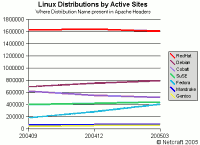Well, that was faster than I expected. Two months ago, Linux distributors Mandrake and Conectiva merged. Last month they announced the combined product line (basically Mandrake Linux with Conectiva’s own stuff merged in.)
Now they’re changing their name to Mandriva. I know the portmanteau is a logical choice from a purely linguistic perspective, but at least to my English-speaking ears it sounds like something out of a low-budget horror movie. Beware the Mandriva or Mandriva, the Terror from Beyond Source. Or maybe a fictional Central American country, the Republic of Mandriva.
Eh, I’ll probably get used to it. I wasn’t too enamored of Linspire, either. (Come to think of it, I still think that one’s a bit clunky.)
At least this should put to rest their long-running trademark dispute with the owner of Mandrake the Magician. Even if they started out with a penguin in a wizard hat, I still don’t think people are going to get a Linux distribution mixed up with a crimefighting comic book magician.
It looks like SuSE’s the only big-gun Linux company who hasn’t changed their name (if you count the Red Hat/Fedora spinoff), and now that they’re part of Novell, I suspect it’s only a matter of time. It’s probably the lack of corporation that’s kept the Slackware and Debian names intact.
